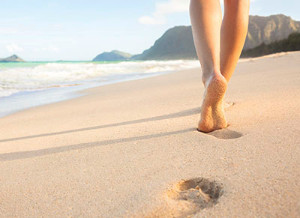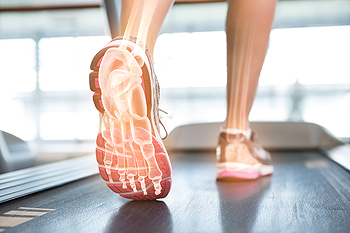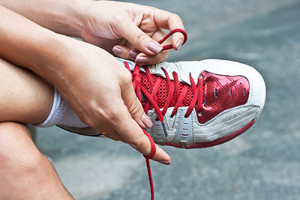
 Although Emilie Reas of San Diego loves to run, there is something about her running that makes her stand out from everyone else. Reas has been able to run different marathons all while being barefoot. After discovering in 2013 that barefoot running can reduce injuries, Reas has opted to stop wearing shoes when she competes. There is a difference in biomechanics between barefoot runners compared to runners who wear sneakers. People who wear sneakers are more likely to land on the heels of their feet when they step, while barefoot runners tend to land on their forefeet.
Although Emilie Reas of San Diego loves to run, there is something about her running that makes her stand out from everyone else. Reas has been able to run different marathons all while being barefoot. After discovering in 2013 that barefoot running can reduce injuries, Reas has opted to stop wearing shoes when she competes. There is a difference in biomechanics between barefoot runners compared to runners who wear sneakers. People who wear sneakers are more likely to land on the heels of their feet when they step, while barefoot runners tend to land on their forefeet.
Barefoot running has its own share of benefits and disadvantages. If you have any concerns about your feet or ankles, contact Dr. Russell J. Ellicott from Augusta Foot Center. Dr. Ellicott will treat your foot and ankle needs.
Barefoot Running
The Impact of Barefoot Running
- Running without shoes changes the motion of your running, as most running is done by landing on the heel of the feet.
- Running barefoot requires a different way of running; the landing is done on the front part of the feet.
The Advantages of Barefoot Running
- When running and landing on the front feet, the impact on the feet and ankle is reduced; this can reduce stress injuries.
- It strengthens muscles in the feet, ankles and lower legs.
- Balance of the body is improved, and there is a greater sensory input from the feet to the rest of the body.
The Drawbacks of Barefoot Running
- No protection while running, makes it likely that runners will land on sharp objects and scrapes, bruises and cuts on the feet will result.
- Blisters may form.
- Possibility of plantar fascia problems.
- Risk of getting Achilles tendonitis.
So what can runners do to make barefoot running safe? It’s best to make a slow transition from running shoes to barefoot running. Once the feet begin to adjust, try walking, then jogging and gradually increasing the distance. Minimalist running shoes may also be an option.
If you have any questions please feel free to contact one of our office located in Augusta, GA. We offer the newest diagnostic and treatment technologies for all your foot and ankle needs.
Read more about Barefoot Running Athlete’s foot is a fungal infection that occurs between the toes. Symptoms of the condition are itchy, dry, red, scaly skin that tends to worsen in the summer when the weather is humid. The infection itself is usually contracted by walking around barefoot in public areas such as locker rooms or gym showers. Treatments for athlete’s foot come in creams, sprays, liquids, and powders, and they will help stop the fungus from growing. If you have athlete’s foot, be sure to wash your feet prior to applying the treatment to the skin and surrounding area. Also, do not apply to open wounds. Contact a podiatrist for tips on how to prevent and treat athlete's foot.
Athlete’s foot is a fungal infection that occurs between the toes. Symptoms of the condition are itchy, dry, red, scaly skin that tends to worsen in the summer when the weather is humid. The infection itself is usually contracted by walking around barefoot in public areas such as locker rooms or gym showers. Treatments for athlete’s foot come in creams, sprays, liquids, and powders, and they will help stop the fungus from growing. If you have athlete’s foot, be sure to wash your feet prior to applying the treatment to the skin and surrounding area. Also, do not apply to open wounds. Contact a podiatrist for tips on how to prevent and treat athlete's foot.
Athlete’s foot is an inconvenient condition that can be easily reduced with the proper treatment. If you have any concerns about your feet and ankles, contact Dr. Russell J. Ellicott from Augusta Foot Center. Dr. Ellicott will treat your foot and ankle needs.
Athlete’s Foot: The Sole Story
Athlete's foot, also known as tinea pedis, can be an extremely contagious foot infection. It is commonly contracted in public changing areas and bathrooms, dormitory style living quarters, around locker rooms and public swimming pools, or anywhere your feet often come into contact with other people.
Solutions to Combat Athlete’s Foot
Athlete’s foot can cause many irritating symptoms such as dry and flaking skin, itching, and redness. Some more severe symptoms can include bleeding and cracked skin, intense itching and burning, and even pain when walking. In the worst cases, Athlete’s foot can cause blistering as well. Speak to your podiatrist for a better understanding of the different causes of Athlete’s foot, as well as help in determining which treatment options are best for you.
If you have any questions please feel free to contact our office located in Augusta, GA. We offer the newest diagnostic and treatment technologies for all your foot and ankle needs.
Read more about Athlete's Foot Walking can provide several benefits to your body. Following a walking routine can help lower your risk of diseases, strengthen your heart, prevent dementia, and boost your energy levels. A good walking routine starts with having healthy feet. Fortunately, there are some tips you can follow to make sure your feet are taken care of. Prior to walking, you should make sure that you are not cutting your toenails too short. Toenails that are short may lead to ingrown toenails and pain. Another tip is to wear breathable socks. This will help prevent unpleasant odors, blisters, and rashes. Lastly, you should make sure you keep yourself hydrated in order to help avoid getting cracked feet.
Walking can provide several benefits to your body. Following a walking routine can help lower your risk of diseases, strengthen your heart, prevent dementia, and boost your energy levels. A good walking routine starts with having healthy feet. Fortunately, there are some tips you can follow to make sure your feet are taken care of. Prior to walking, you should make sure that you are not cutting your toenails too short. Toenails that are short may lead to ingrown toenails and pain. Another tip is to wear breathable socks. This will help prevent unpleasant odors, blisters, and rashes. Lastly, you should make sure you keep yourself hydrated in order to help avoid getting cracked feet.
Everyday foot care is very important to prevent infection and other foot ailments. If you need your feet checked, contact Dr. Russell J. Ellicott from Augusta Foot Center. Dr. Ellicott can provide the care you need to keep you pain-free and on your feet.
Everyday Foot Care
Often, people take care of their bodies, face and hair more so than they do for their feet. But the feet are a very important aspect of our bodies, and one that we should pay more attention to. Without our feet, we would not be able to perform most daily tasks.
It is best to check your feet regularly to make sure there are no new bruises or cuts that you may not have noticed before. For dry feet, moisturizer can easily be a remedy and can be applied as often as necessary to the affected areas. Wearing shoes that fit well can also help you maintain good foot health, as well as making it easier to walk and do daily activities without the stress or pain of ill-fitting shoes, high heels, or even flip flops. Wearing clean socks with closed shoes is important to ensure that sweat and bacteria do not accumulate within the shoe. Clean socks help to prevent Athlete’s foot, fungi problems, bad odors, and can absorb sweat.
If you have any questions please feel free to contact our office located in Augusta, GA. We offer the newest diagnostic and treatment technologies for all your foot and ankle needs.
Read more about Every Day Foot Care The first step to getting into a proper running routine is to make sure you are wearing the right running shoes. The proper shoe will help to correct biomechanical issues and prevent injury. You should always go to a sneaker store that specializes in running shoes so that the workers can help you find a sneaker that fits your foot strike. There are three main types of runners based on foot strikes: overpronators (when the foot rolls inward too much), neutral pronators (feet roll inward slightly), and supinators (feet don’t roll inward enough). Certain running shoe stores will have you run on a treadmill so that the workers can best determine which shoe type will fit you properly. You will know the shoe is a good fit if you “feel like you want to go run immediately," said runner Dimity McDowell.
The first step to getting into a proper running routine is to make sure you are wearing the right running shoes. The proper shoe will help to correct biomechanical issues and prevent injury. You should always go to a sneaker store that specializes in running shoes so that the workers can help you find a sneaker that fits your foot strike. There are three main types of runners based on foot strikes: overpronators (when the foot rolls inward too much), neutral pronators (feet roll inward slightly), and supinators (feet don’t roll inward enough). Certain running shoe stores will have you run on a treadmill so that the workers can best determine which shoe type will fit you properly. You will know the shoe is a good fit if you “feel like you want to go run immediately," said runner Dimity McDowell.
If you are a runner, wearing the right running shoe is essential. For more information, contact Dr. Russell J. Ellicott from Augusta Foot Center. Dr. Ellicott can provide the care you need to keep you pain-free and on your feet.
Choosing the Right Running Shoe for Your Foot Type
To increase performance and avoid the risk of injury, it is important to choose the right running shoe based on your foot type. The general design of running shoes revolves around pronation, which is how the ankle rolls from outside to inside when the foot strikes the ground.
If you have any questions please feel free to contact our office located in Augusta, GA. We offer the newest diagnostic and treatment technologies for all your foot and ankle needs.
Read more about Choosing the Right Running Shoe for Your Foot Type